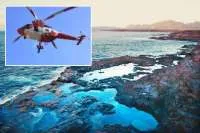Why are there so many earthquakes between Gran Canaria and Tenerife?
- 19-03-2023
- Gran Canaria
- INVOLCAN / IGN
After the eruption in La Palma, seismic activity is being more closely monitored than ever before, however, La Isla Bonita is not the place with the most activity in the Canary Islands. The area with the most tectonic seismic activity is located in the channel that separates the islands of Gran Canaria and Tenerife where the Enmedio underwater volcano sits, and between 400 and 500 earthquakes are detected here every year.
In the first two months of this year, the National Geographic Institute (IGN) has registered 120 earthquakes halfway between the two islands, which represents 30% of all earthquakes detected in the whole archipelago in this period, the largest measuring 3.4 on the Richter scale.
However, in the last three years, most of the tremors located in the Canary Islands have been associated with the Cumbre Vieja volcano, in La Palma, which continues to register some activity typical of its post-eruptive phase.
What happens in the crust and mantle of this area so that it continues to tremble?
To investigate this and other aspects of the oceanic floor on which the archipelago is based, the IGN and the Institute of Marine Sciences (ICM-CSIC) have embarked on a project called 'Geodynamic processes and natural risks in the Canary Islands archipelago' (GUANCHE), which will study the structure of the crust and the mantle by observing the seabed more closely, according to the IGN seismologist, Itahiza Domínguez.
“There is continuous seismicity between Gran Canaria and Tenerife. We have evidence of it since earthquakes began to be documented in the Canary Islands in the 1950s, when the first seismic station was installed, and then, with the expansion of the network during the 70s”.

“We do not know the origin of the seismicity. We don't even know what relationship it has with the Enmedio volcano", points out the seismologist who with this research will have the opportunity to confirm that the continued seismic activity between Gran Canaria and Tenerife "has nothing to do with volcanoes, but with the tectonic structure of the archipelago”.
Domínguez highlights that the Canary Islands are within the African plate, but between Tenerife and Gran Canaria there is a fracture where some tension occurs. "When the crust moves, it causes small earthquakes, and this research will help to explain the origin of the Enmedio volcano, as well as provide new clues about the origin of the Canary Islands archipelago.”
"Almost certainly the seismic activity is before the Enmedio volcano," suspects the seismologist who bases his statement on two issues. The volcano is recent from a geological point of view, as it is only ‘several’ thousand years old, and the seismicity linked to volcanism is intense before and after the eruption and then gradually disappears, something that does not occur in this area.
Gauge potential risk.
In addition, the largest earthquakes in the archipelago occur in this area. “In 1989 one of magnitude 5.2 was registered that was widely felt in Gran Canaria and Tenerife. We want to know if that is the limit and to know the seismic danger in case it could entail some risk, "says the seismologist.
On the other hand, in recent years several swarms of hundreds of earthquakes have been detected in this area.
The GUANCHE project, coordinated by Antonio Villaseñor from the Institute of Marine Sciences of the Higher Centre for Scientific Research (ICM-CSIC), includes two areas of work; one on geodynamic processes and another focused on the natural risks of the Canary archipelago.
These investigations have a budget that will be carried out until the year 2025.
Other articles that may interest you...
Trending
Most Read Articles

Featured Videos
A Vision of Elvis Tenerife Promo
- 10-05-2025
TEAs 2025 Highlights
- 17-11-2025


























































